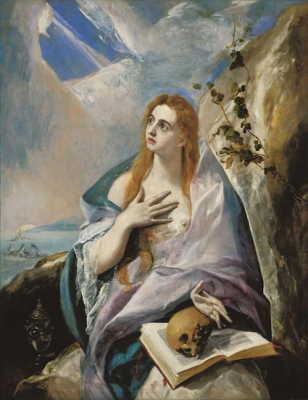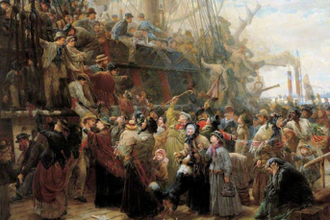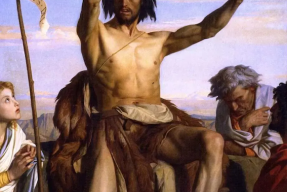Gospel in Art: Feast of Saint Mary Magdalen

The Penitent Mary Magdalen by El Greco 1576-1577 © Museum of Fine Arts, Budapest
Source: Christian Art
Gospel of 22 July 2025
John 20:1-2, 11-18
On the first day of the week Mary Magdalene came to the tomb early, while it was still dark, and saw that the stone had been taken away from the tomb. So she ran and went to Simon Peter and the other disciple, the one whom Jesus loved, and said to them, 'They have taken the Lord out of the tomb, and we do not know where they have laid him.'
Mary stood weeping outside the tomb, and as she wept she stooped to look into the tomb. And she saw two angels in white, sitting where the body of Jesus had lain, one at the head and one at the feet. They said to her, 'Woman, why are you weeping?' She said to them, 'They have taken away my Lord, and I do not know where they have laid him.' Having said this, she turned round and saw Jesus standing, but she did not know that it was Jesus. Jesus said to her, 'Woman, why are you weeping? Whom are you seeking?' Supposing him to be the gardener, she said to him, 'Sir, if you have carried him away, tell me where you have laid him, and I will take him away.' Jesus said to her, 'Mary.' She turned and said to him in Aramaic, 'Rabboni!' (which means Teacher). Jesus said to her, 'Do not cling to me, for I have not yet ascended to the Father; but go to my brothers and say to them, "I am ascending to my Father and your Father, to my God and your God." ' Mary Magdalene went and announced to the disciples, 'I have seen the Lord' - and that he had said these things to her.
Reflection on the painting
Mary Magdalene speaks to the seeker in all of us. In the Gospel reading for her feast, the risen Lord asks her, "Woman, why are you weeping? Who are you looking for?" Mary wept because she could not find Jesus, whom she was seeking. Much of the sadness in our lives stems from a sense of loss and unfulfilled longing. We have all experienced this particular sadness, longing for something or someone, and feeling a deep sense of sorrow when that longing is unfulfilled.
In the Gospel reading, however, Mary's longing for Jesus was finally fulfilled. When the risen Lord spoke her name, she recognized him, and her sadness was transformed into joy. Even in that moment of great joy, though, she had to learn to let go of Jesus as she had known him. Jesus told her not to cling to Him because he was returning to the Father. From that point on, he would relate to her and all his disciples in a new way, being as close as ever, but in a very different manner. This Gospel reading assures us that even if many of our longings remain unsatisfied, our deepest longing for the Lord will always be fulfilled. The Lord calls each of us by name, just as he called Mary.
On this feast of Saint Mary Magdalene, we honour the woman who stood faithfully at the foot of the Cross and was the first to encounter the Risen Christ. Once broken and searching, she was transformed by the mercy of Jesus and became the "apostle to the apostles" ("apostola apostolorum" in Latin, was first formally used by Saint Thomas Aquinas) carrying the light of the Resurrection to those still in darkness. Her story reminds us that no wound is too deep, no past too heavy, for Christ to redeem.
Our painting is by El Greco. It was once claimed that El Greco painted using a splinter from a wooden cross, never altering a single brushstroke, so that each stroke was seen as an expression of God's will. While this tale is more legend than fact, it conveys something profound: the idea that his art was an act of devotion, each painter mark laid down in obedience to a higher inspiration. Our painting portrays the penitent Mary Magdalene, caught in a moment of profound spiritual transformation. A radiant shaft of light in the top left corner floods the scene, as though cleansing her soul and gently lifting her beyond the confines of earthly existence. The skull (symbol of mortality) has slipped from her hand, no longer held, as if death itself has lost its grip. Behind her, a winding ivy plant reaches skyward, a sign of eternal life. The dawn landscape, washed in cool, moonlit tones, mirrors her inner renewal: a quiet, ethereal backdrop to a powerful encounter with grace.
LINKS
Gospel in Art: https://christian.art/
Today's Reflection: https://christian.art/daily-gospel-reading/john-20-1-2-11-18-2025/
Latest Video - The Face of Christ: www.indcatholicnews.com/news/52811


















